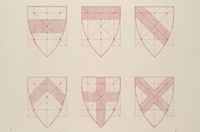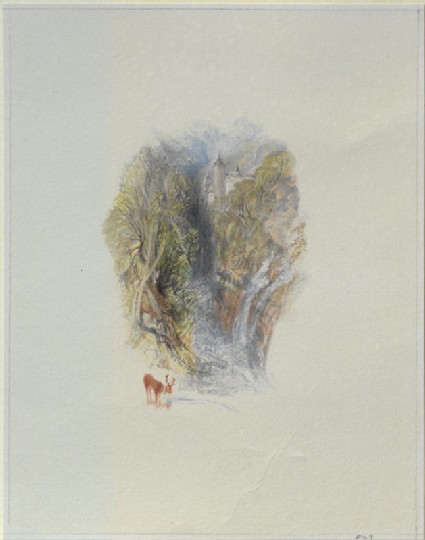Ruskin's revision to the Rudimentary series (1878)
Unpublished manuscript catalogue for proposed re-organisation of the Rudimentary series.

Ruskin's Catalogues: 1 object
Show search help- Reference URL
Actions
Drawing of Turner's "Valombré" William II Ward
-
Ruskin text
R|149} The Falls in Vallombré. Composition. Copy of Turner. W. Ward. -
Details
- Artist/maker
-
William II Ward (1829 - 1908)after Turner (Joseph Mallord William Turner) (1775 - 1851)
- Object type
- drawing
- Material and technique
- watercolour and bodycolour over graphite on wove paper
- Dimensions
- 229 x 181 mm
- Associated place
-
- Europe › France › Rhône-Alpes › Valombré Valley › Valombré Valley (subject)
- Inscription
- Recto, bottom right, in graphite: R149
Verso:
bottom right, partially trimmed away, in graphite: R 149 | Ward | after Turn[er] | formerly
bottom, just left of centre, the Ruskin School's stamp
- Provenance
-
Presented by John Ruskin to the Ruskin Drawing School (University of Oxford), 1875; transferred from the Ruskin Drawing School to the Ashmolean Museum, c.1949.
- No. of items
- 1
- Accession no.
- WA.RS.RUD.149
-
Subject terms allocated by curators:
Subjects
-
References in which this object is cited include:
References
Ruskin, John, The Ruskin Art Collection at Oxford: Catalogue of the Rudimentary Series, in the Arrangement of 1873, ed. Robert Hewison (London: Lion and Unicorn Press, 1984), cat. Rudimentary no. 149, RUD.149
Ruskin, John, Instructions in Practice of Elementary Drawing, Arranged with Reference to the First Series of Examples in the Drawings Schools of the University of Oxford (n.p., [1872]), cat. Rudimentary no. 149
Ruskin, John, Instructions in the Preliminary Exercises Arranged for the Lower Drawing-School (London: Smith, Elder, 1872), cat. Rudimentary no. 149
Ruskin, John, Instructions in the Preliminary Exercise Arranged For the Lower Drawing-School (London: Spottiswoode, 1873), cat. Rudimentary no. 149
Ruskin, John, ‘Rudimentary Series 1878’, 1878, Oxford, Oxford University Archives, cat. Rudimentary no. 137
Ruskin, John, ‘The Ruskin Art Collection at Oxford: Catalogues, Notes and Instructions’, Edward T. Cook and Alexander Wedderburn, eds, The Works of John Ruskin: Library Edition, 39 (London: George Allen, 1903-1912), 21, cat. Rudimentary no. 149
Location
-
- Western Art Print Room
Position in Ruskin’s Collection
Ruskin's Catalogues
-
Ruskin's Rudimentary series, 3rd ed. (1872)
R|149} The Falls in Vallombré. Composition. Copy of Turner. W. Ward. -
Ruskin's Rudimentary series 4th ed. (1872)
R|149} The Falls in Vallombré. Composition. Copy of Turner. W. Ward. -
Ruskin's Rudimentary series, 5th ed. (1873)
R|149} The Falls in Vallombré. Composition. Copy of Turner. W. Ward. -
Ruskin's revision to the Rudimentary series (1878)
now 149 137.The falls in Vallombre, one of the vignettes to Roger’s poem of Jacqueline. The literature and the illustrations of the two volumes of Roger’s Works are in envious harmony. Roger’s Italy is a much less studied piece of writing than his other poems, and it is of far higher quality than any of them: Turner’s illustrations to the Italy never contain more than half the work of the illustrations to the Poems and are always at least three times as good. In this instance we have a pretty example which we may oppose directly to the subject of Martigny No. 133 . The Martigny is the illustration of a story in the ‘Italy’ called Marguerite, and this is the illustration of a story in the Poems called Jacqueline. Marguerite goes to a real place viz. Martigny whereat she keeps the inn of The Silver Swan. Turner draws the real place with perfect ease and produces a noble work of art. Jacqueline, on the contrary, goes to the falls in Vallombre, but there are no R. such falls and there is no such valley. The name is merely adopted by Rogers from Vallombrosa in order to help him out with a rhyme. Turner invents falls and valley, hesitating between reminiscences of the Tees and the Anio for the water, and between Rhymer’s Glen and the Via Mala for the valley; he elaborates the composition with his most exquisite care, and yet the utmost that we can say of it is that it is a beautiful bit of work entirely incredible. For all that the advanced student will find the greatest advantage in copying work so exquisite, and I have seldom seen a better illustration of the power of composition than the height and the extent given to the ravine merely by the placing of the figure of the stag. The cast shadows of the trees above are also of immense constructive importance.





